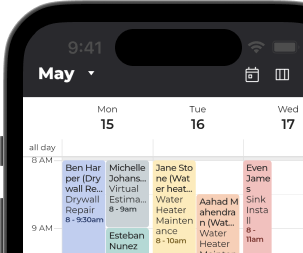Role-playing, mock calls, puzzles – you’ve probably seen these before. They’re team-building activities that help you improve your communication skills.
Teams with good communication are more productive, support each other, and navigate conflicts quickly, so your business runs smoothly and gets more done. It also means employees are better equipped to handle customer concerns because they know how to collaborate.
Free: Small Business Communication Guide
Yes, communication is vital, but is it eating up all your whole day? Take back those hours now!
Save Now
In this post, we’ll discuss the importance of building communication skills and how you can do so through games and activities. We’ve also compiled a list of team-building activities for you to try — some are more fun than strategic, but each strengthens communication and encourages employees to support each other.
What Are Team-Building Activities?
Team-building activities are games that encourage people to work together or develop a particular communication skill. By encouraging collaboration, coworkers study each other’s personalities and communication styles, and learn how to talk openly and listen actively.
While these games are designed to be fun and engaging, they also foster trust and teamwork among your employees.
Even business owners who don’t manage teams can benefit from team-building activities. By improving your communication skills, you’ll avoid customer conflicts, close deals, and create strong business partnerships.
Now, let’s review the best team-building activities for communication skills.
Team Building Activities for Communication Skills
These team-building activities enhance valuable soft skills that can help you win more business:
- Scavenger hunts
- Puzzles
- Minefield
- Charades
- Escape Room
- Human Knot
- Back-to-back drawing
- Deserted Island
- The Perfect Square
- Emoji Decoder
- Minute to Win it
- Virtual DnD
Communication Games for Team Building
These team-building activities strengthen active listening skills and sharpen strategic thinking. Most can be done with as few as four people.
1. Scavenger Hunts
Break into pairs or small groups and give everyone the same scavenger hunt to complete. Feel free to place items outside or make it a remote game. Participants don’t have to search for physical items; you can have them post pictures instead. For example, ask them to draw something on a Post-it note and stick it to their partner, roommate, or friend’s head. That breaks the ice between coworkers and makes the game lighthearted and fun.
Just make sure everyone on the pair/team is assigned an objective. That will encourage fast-paced, active communication.
Scavenger hunts are flexible – you can add variables like time limits, prizes, or special rules. No matter how you play, this game improves communication and conflict-resolution skills.
2. Puzzles
Snag some cool puzzles, then break your employees into teams or pairs. Split the puzzle pieces between team members and give them time to assemble the puzzle. They’ll have to create a strategy and work together to assemble it before the deadline.
Puzzles uncover different problem-solving strategies and teach you about your coworkers’ learning styles. This activity helps employees collaborate, even when they have different opinions. It’ll also show them why they should value other perspectives and, hopefully, seek out those viewpoints later on.
Hanyama puzzles are great for building communication skills. They’re fun to tinker with, and most have multiple solutions. They encourage employees to work together, test new strategies, and be creative when problem-solving.
3. Minefield
You’ll need at least four people for this game, sorted into pairs. Lay out a series of obstacles like balls, tape, cones, or anything you can find. Have one person start on one end, blindfolded, and the other person waiting on the other side. The waiting partner will use verbal cues and instructions to guide the blindfolded person through the “minefield.” Step up the stakes by having the blindfolded person carry something fragile, like an egg on a spoon.
This game forces everyone out of their comfort zone – one person is waiting to listen, and the other has to be clear when giving directions.
4. Charades
Yes, this classic parlor game also has communications benefits!
Think about it: when you play charades, which team usually wins? Typically, it’s the team where the partners know each other best and understand their communication styles.
If you’ve never played charades, break everyone into two groups. Create a list of actions or phrases, and have one person randomly pick one of these topics to act out (no speaking!). Their teammates will try to guess which action or phrase it is based on the actor’s gestures. If the team guesses correctly before the timer runs out, they get a point. If not, the other team can try to guess and steal that point.
Charades encourages people to be active listeners, focusing on movements and signals from their partners. It’s a great game to work on nonverbal communication skills like body language and hand gestures.
5. Escape Room
Escape rooms are living puzzles, where a team is placed in a locked room and works together to “escape.” If you’ve done one before, you know that it requires constant communication and teamwork. The time limit adds pressure, and the variety of activities within the room means everyone gets to contribute. Like puzzles, escape rooms rely on people using different viewpoints and creativity to solve the problem.
6. The Human Knot
The human knot is a classic team-building activity. Participants form a circle, and each person holds hands with someone who is not sitting beside them. The objective is to untangle yourselves without letting go or loosening your grip.
The human knot forces you to communicate and, more importantly, collaborate. If everyone pulls in opposite directions, you’ll never untangle the knot. You have to work together and talk through each step to succeed.

The Small Business Communications Time Suck is Real
The right communication is vital to your success as a small business. But sometimes it can eat up too much of your time. We’ll show you how to streamline communications in this free guide.
Small Group Communication Activities
These next three suggestions are communication activities for small groups. You can do most of them with only two people. Working in small groups helps employees practice one-on-one conversations, which is particularly useful for customer communication.
7. Back-to-Back Drawing
You only need two people for this activity. Have partners sit back-to-back and give one a whiteboard or sketch pad. Give the other partner a list of everyday items such as a car, a coffee mug, a laptop, etc.
The person with the list describes an item without saying what it is. The person drawing tries to create the image based on the speaker’s description.
It’s a tough game, but it teaches you how to be descriptive and demonstrates the value of clear communication.
8. Deserted Island
Break up into pairs or small groups of three to four people. Then, tell everybody they are on a deserted island and give them a list of about 20-30 items. Ask each team to pick five items they would keep if deserted on that island. Make sure they explain why they would keep each one and eliminate others.
Here’s what a list might look like:
- Chair
- Tent
- Stove
- Games
- Matches
- Book
- First Aid
- Knife
- Rope
- Shovel
- Compass
- Flashlight
The purpose of this game is to think outside the box. Team members must compromise and create a strategy ensuring their “survival.” It teaches people to think critically and be open to new ideas and perspectives.
9. The Perfect Square
For this game, you’ll need a rope and blindfolds for each participant. One person won’t have a blindfold but will be in charge of directing everyone else. The goal of the game is to create a perfect square without taking off the blindfolds.
This activity teaches coworkers to trust each other and follow directions. It also helps the person talking improve their communication skills. It’s great for business leaders and people who manage small teams.

The Small Business Communications Time Suck is Real
The right communication is vital to your success as a small business. But sometimes it can eat up too much of your time. We’ll show you how to streamline communications in this free guide.
Remote-Friendly Communication Games
These are some of our favorite communications activities for remote teams. They can also be played in person.
10. Emoji Decoding
Break your team into groups of 2-4 people and assign one person to be the “writer.” Give that person a paragraph of text (like a passage from a book) and have them “translate it” into emojis.
Then, ask the writer’s team to decipher the emojis and see how close they are to the original text. Have team members take turns being the writer so everyone can get better at giving and receiving feedback. This game is really fun and involves different creative styles.
You can also do this activity through apps like TeamChat, so try it out when your team needs an icebreaker during your next meeting. If you’re wondering what this message says, it reads, “Surprise party on March 21st!”
11. Minute to Win It
Split everyone into groups and give them a list of tasks based on the number of people on each team. For example, if you have four people, you’ll have four tasks.
The tasks should be random, like “draw as many farm animals as you can,” “name sports teams that start with R,” or “write a story about a lost cat. ”
Give each team a moment to decide who completes which task. Then, everyone gets one minute to complete it. Not only does this foster trust between employees, but it gives people a chance to showcase their unique skills and strengths. Knowing what your team is best at can help you resolve future conflicts.
12. Video Games
Video games are fun, but they can also be educational. Online games like ToonTown, Runescape, and Dungeons and Dragons are great for team collaboration.
Not only do you have to work together, but you also have to devise your own strategy for success. Asking people to participate in a game for 30 minutes each month creates a consistent bonding experience for your employees.
Trying Team Building Activities
For small businesses that rely on close-knit teams, trust, and mutual respect are just as important as any other workplace skill. As a business owner, it’s your job to create a productive environment and encourage healthy communication between coworkers.
You can choose the best team-building activities from this list or create your own. Remember to focus on teamwork and respect and remind your employees that small businesses can have fun, too.

The Small Business Communications Time Suck is Real
The right communication is vital to your success as a small business. But sometimes it can eat up too much of your time. We’ll show you how to streamline communications in this free guide.





